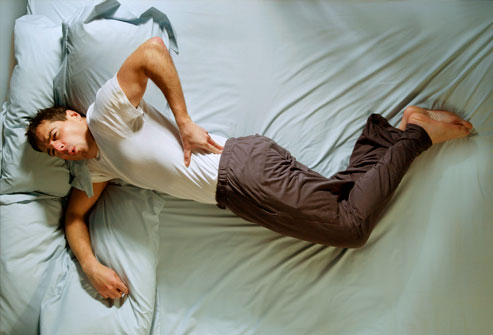My chiropractic patients often blame their back pain on poor quality mattresses. Sadly, they wake up sore in the low back, hips, and shoulders. The mattress they invested too much money on just a few years ago seems to be the culprit. Before ditching an expensive mattress for a newer model, it is important to learn what sleeping positions may be responsible for low back pain and what movements during the day exacerbate back issues.
Spinal muscles and their roles:
Several muscle groups attached to the spine play a critical role in spinal health. Problems with these muscles are responsible for most low back pain cases. Learning some simple anatomy will make it clearer why certain movements and sleeping positions cause so much pain.
- Iliopsoas (psoas + iliacus) complex
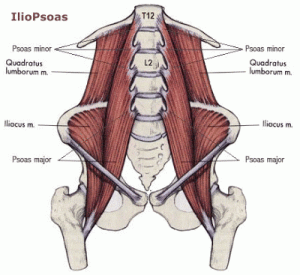
These lie deep within the abdomen and hip, connecting the lumbar vertebrae and the iliac crest to the top of the femur. They’re major movers during bent knee leg raises and sit-ups.
Aggravated by: Excessive sitting/driving, lots of kicking (martial arts or soccer), long bike rides in bent position, and
sleeping in the fetal position.
- Paraspinals
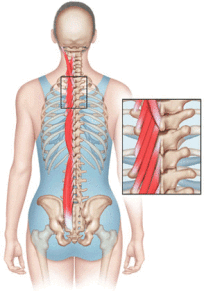
These are like the spine’s “suspenders” and help to control rotation, extension and bending. This group includes the erector spinae and multifidus along the spine.
Aggravated by: Sudden spinal overload, repetitive movement with poor technique, hunched posture, tight abdominal muscles, and lots of sitting.
- Rectus abdominis
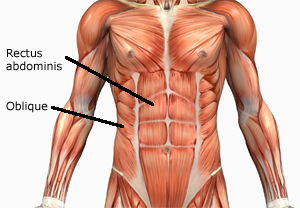 This sheet of muscle is your “washboard abs.” It runs between the lowest ribs and top of the pubic bone, and helps stabilize the torso. Excessive training of the rectus abdominis (at the expense of posterior chain muscles) can diminish the ability to carry weight overhead (think jerks, snatches, overhead presses) and lead to lower back injury.
This sheet of muscle is your “washboard abs.” It runs between the lowest ribs and top of the pubic bone, and helps stabilize the torso. Excessive training of the rectus abdominis (at the expense of posterior chain muscles) can diminish the ability to carry weight overhead (think jerks, snatches, overhead presses) and lead to lower back injury.
So: fewer crunches, more swings.
Aggravated by: Too many crunches (especially without posterior chain training), over-exercising, excess abdominal fat, and reliance on weight training belts.
- Gluteus group: maximus/medius/minimus
AKA: the booty, these are the muscles that help bring your thigh behind you (think: donkey kicks), rotate it, and bring it to the side.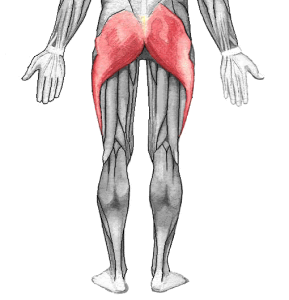
Aggravated by: Prolonged sitting, sleeping in fetal position with knees pulled up, sitting on your wallet, standing for long periods on one leg, sleeping on your back with feet splayed under the weight of a heavy blanket.
- Piriformis
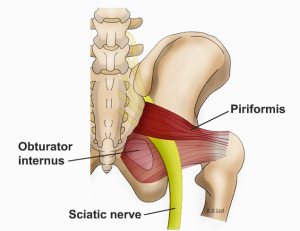 This small muscle lies deep within the glutes and connects the thigh to the pelvis near the sacrum. It rotates the thigh outward and swings the leg to the side when the thigh is flexed.
This small muscle lies deep within the glutes and connects the thigh to the pelvis near the sacrum. It rotates the thigh outward and swings the leg to the side when the thigh is flexed.
Aggravated by: Distance running (repetitive overuse in general), prolonged contraction (such as driving a car), sitting with one foot underneath the body, walking with duck feet (toes out), sitting too much.
- Quadratus lumborum
The “QL” lies deep in the side of the torso around the kidneys. It helps to bend, rotate, and straighten the torso from bent 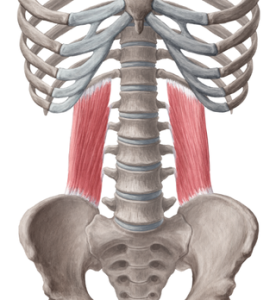 position. It also helps with exhalation (coughing, etc.). Many folks discover when they strain the QL, they live in constant fear of sneezing.
position. It also helps with exhalation (coughing, etc.). Many folks discover when they strain the QL, they live in constant fear of sneezing.
Aggravated by: Structural imbalances (one leg longer, uneven pelvis, etc.), habitual leaning to one side, slouching, always sleeping on one side.
- Hamstrings
 These big leg muscles run along the back of the thighs, attaching at the hip and the knee. They bend and stabilize the knee.
These big leg muscles run along the back of the thighs, attaching at the hip and the knee. They bend and stabilize the knee.
Aggravated by: Pressure from chairs, prolonged sitting, bed rest, overload (e.g. lots of sprints when a trainee isn’t used to sprinting).
The following are multifactorial spinal problems that lead to pain:
- Poor mobility in surrounding muscles
- Bad biomechanics
- Poor posture
- Weakness of supporting musculature
- Muscle imbalances
- Sedentary lifestyle, sitting, and immobility
Poor mobility in surrounding muscles:
The pelvis is the foundation for the spine. Decreased mobility in the hips, hamstrings, ankles, and thoracic spine can lead to overcompensation at the lumbar spine and excessive pelvic tilt. This problem is particularly common in women.
Bad Biomechanics:
Back pain only gets worse with poor biomechanics. Most spine injuries that occur are muscle strains or ligament sprains, usually due to improper loading and technique. A common error is lumbar flexion during movements like bending, lifting, and squatting. Excessive lumbar extension is also dangerous and can lead to vertebral fracture (e.g. extending the lumbar spine when standing up).
The safest position for the lumbar spine is a neutral position — a natural but not exaggerated S-curve. You can find a neutral spine by flexing your lumbar spine, then extending it and trying to find the midpoint between the two or by standing tall and taking a deep breath. Use a mirror to check.
Avoid the rounded posture on the left when lifting; instead, aim for a neutral spine. It’s important to get better at the movements that you regularly do.
Double check squat form:
- Take a wider stance (at least shoulder width, if not wider)
- Use natural foot positioning (similar to other athletic movements)
- Keep heels in contact with the floor
- Gaze forward or slightly up
- Maintain lordotic curve in lower back — don’t round
- If back squats don’t work, try front, zercher and goblet squats
- Focus on hip extension — drive from the glutes and hips.
Poor Posture:
If your posture stinks, your back health stinks. Poor posture means higher levels of stress on the spine. When posture is appropriate (proud chest, natural lumbar curve, tight core, retracted shoulder blades, etc.) – then we are able to handle higher amounts of compressive force. Also, a big gut and high-heeled shoes can negatively influence posture. Try to avoid one or both as much as possible.
Weakness:
Many people assume that strong abdominals help them bend and twist. This is true, in part, but most often the core’s role is stability rather than movement — in other words, preventing motion rather than initiating it. Too much flexion or extension at the lumbar spine, usually caused by weak core muscles, can lead to injury. It’s also biomechanically weaker. You can throw a lot farther or punch a lot harder when your hips and shoulders are involved than when you’re just twisting at the waist. Try incorporating these movements into your workout; a wood chop with a cable system is one idea.
Imbalances:
Folks with chronic back pain often neglect the posterior chain (i.e. the muscles that run along the rear of the body from neck to ankles). This is especially true for gym rats who do too much bench pressing and not enough pulling or hip extension. This keeps back problems in full force. Single leg exercises help develop the lower body and immediately challenge the lower back and hips, building stability and function. Try a one legged squat off of 8” step to decrease your hip imbalances.
Not Moving:
Doctors used to recommend bed rest for back pain. Now they usually recommend movement. As you can see from the list of muscle problems above, “too much sitting” factors into a host of back problems. When we sit or lie around all day, intervertebral discs absorb fluid and become tighter, allowing less range of motion and promoting injury. Introduce yourself to regular movement (warm ups, yoga, and dynamic joint mobility, along with walking and swimming). These movements will help preserve spinal health.
Look For Help:
Fixing a bad back is a complicated endeavor. Changing bad posture, muscle imbalances, harmful habits, spinal biomechanics issues, and adaptive movement patterns are both time-consuming and difficult to accomplish. The help of a chiropractor trained in the art of helping joints and tissues heal while retraining the muscular stabilization system can be a life changing experience. If you have been thinking of getting to the chiropractor don’t delay! Each new day is a day that you could be closer to a pain-free back and your body’s optimal health.
Upcoming Low Back Pain Class
“Improving Your Low Back”
Tuesday, November 10th @ 6:00pm
Register with our Roanoke, Virginia office by calling:
Video Recommendations:
Sleep Positions and Low Back Pain with Dr. Rich—https://youtu.be/TkF13gRvXaw
5 Exercises To Fix Your Low Back Pain with Dr. Rich—https://youtu.be/f8XoIoiMmA4
Foundation Training—A great video for Low Back Pain Patients—https://youtu.be/4BOTvaRaDjI
Myths Of Low Back Pain—Dr. Stuart McGill, a mentor of mine—https://youtu.be/033ogPH6NNE
The Glutes Role In Low Back Pain—Dr. Craig Liebenson, a mentor of mine—https://youtu.be/eCSjIhPBHj0

Dr. Daryl Rich, DC, CSCS

